When it comes to enhancing the performance and adaptability of our trolling motors, adjustable depth collars are a game changer. We've all faced challenges with maintaining efficient propeller depth across varied water conditions. These collars allow us to quickly alter the depth, guaranteeing ideal motor functionality. But how do we choose the correct collar, guarantee it's installed properly, and maintain it for peak performance? Join us as we explore these vital elements, reveal the secrets behind maximizing motor versatility, and discover the impact on our fishing success.
Understanding Adjustable Depth Collars
Adjustable depth collars embody the versatility and precision that every angler seeks in a trolling motor. They're designed to let's change the depth of our motors in the water smoothly, offering us the freedom to navigate different fishing environments easily.
Made from durable materials, these collars promise long-lasting performance, even against water and the stress of operation. Users like us appreciate this durability, often noting its ability to keep our motors stable and prevent accidental deployment during our adventures. The small collar specifically fits all 12v motors, making it versatile for those who utilize lower voltage systems in their fishing endeavors.
To operate these collars, we simply slide them along the motor shaft and lock them at our desired depth. It's important to adjust the collar when the motor is partially stowed, allowing us the flexibility we need without the risk of unexpected changes mid-motion.
Engaging with user feedback, manufacturers like Minn Kota have designed versions that add variation in compatibility and function, like the popular Minn Kota Terrova model. This attention to detail—even in troubleshooting—ensures that we've the best experience possible.
Benefits of Depth Adjustment
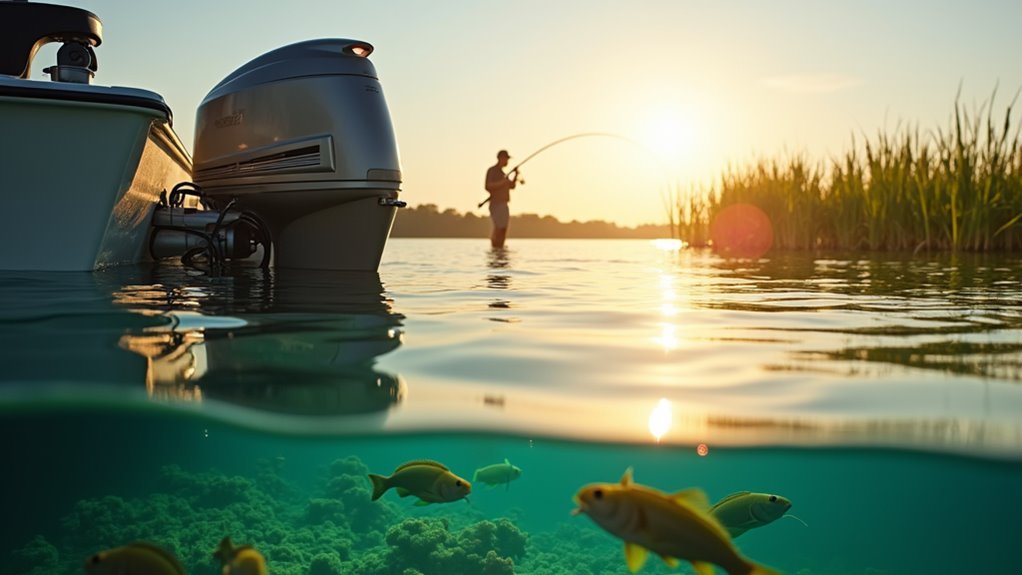
As anglers, precision and control are at the heart of our adventures on the water, and the ability to adjust our trolling motor's depth substantially enhances these aspects. Imagine gliding across shallow waters without the fear of grounding our boat. With environmental adaptability, we adjust the motor height to maintain our propeller's depth slightly deeper than the boat's bottom. This small change can keep us from hitting the bottom or getting stuck, letting us explore those skinny waters without a hitch.
In varying conditions, performance optimization becomes our ally. Changing water levels or heavier boat loads need different motor depths, and the ability to easily tweak the height guarantees our ride stays smooth. We maneuver confidently against wind and currents, enhancing our control and keeping our fishing game strong. Trolling motors, like the Minn Kota Riptide Ulterra 112, possess the power to hold boats up to 5,500 pounds in place, even in challenging conditions. For those specific techniques like bottom fishing or fluke drifting, precise depth adjustment optimizes how our boat moves and how we present our bait, making every catch more thrilling.
Safety and convenience wrap up the benefits. By managing depth properly, we extend the motor's lifespan and reduce strain, allowing us longer, stress-free days on the water, focusing on what truly matters—freedom and fishing.
How to Install a Depth Collar
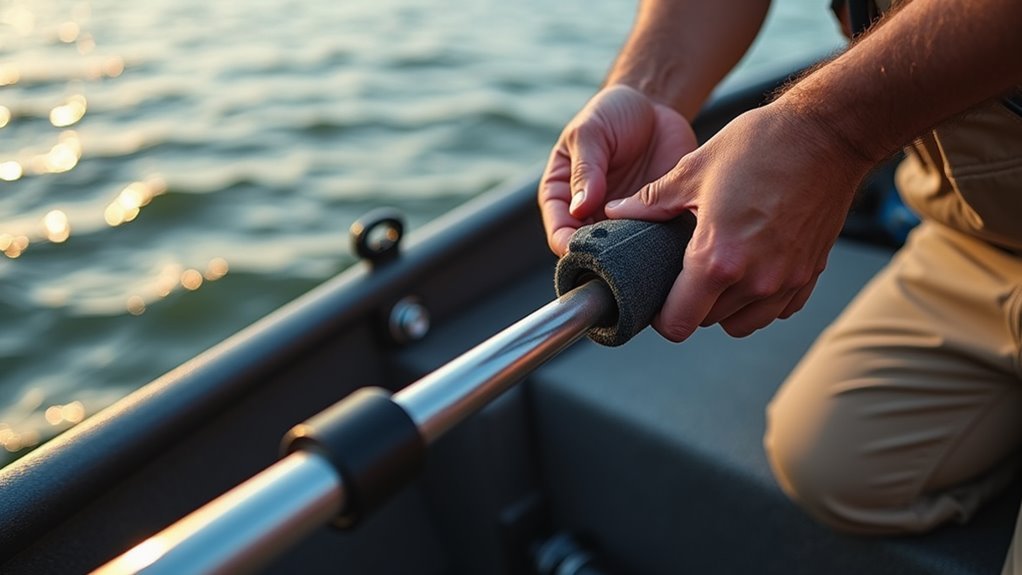
Installing a depth collar is a straightforward process that enhances the performance of our trolling motor. To kick things off, we start by stowing our motor, guaranteeing it's safe to work on. This freedom from concern allows us to focus on the real task: improving our motor's efficiency with depth precision and collar durability.
We begin by loosening the collar on the motor shaft, an action that brings us the flexibility we crave. By sliding the collar, we can raise or lower the trolling motor, customizing our experience to suit different water conditions. It's also possible to use heat to install the depth collar, which can expand it for easier fitting over the shaft.
It's a hands-on approach that helps us feel more connected to our gear.
Before securing the collar into our chosen position, we might need to remove the head from the shaft. This gives us access to the wiring, letting it pass through the collar slit without a hassle.
After positioning the collar, verifying it aligns with the manufacturer's groove on models like Garmin Force, we tighten it to prevent any slippage.
As we deploy the motor and check its depth, we're assuring ourselves of peak motor performance. This confident setup guarantees our adventures are as smooth as they're exciting.
Tips for Optimal Positioning
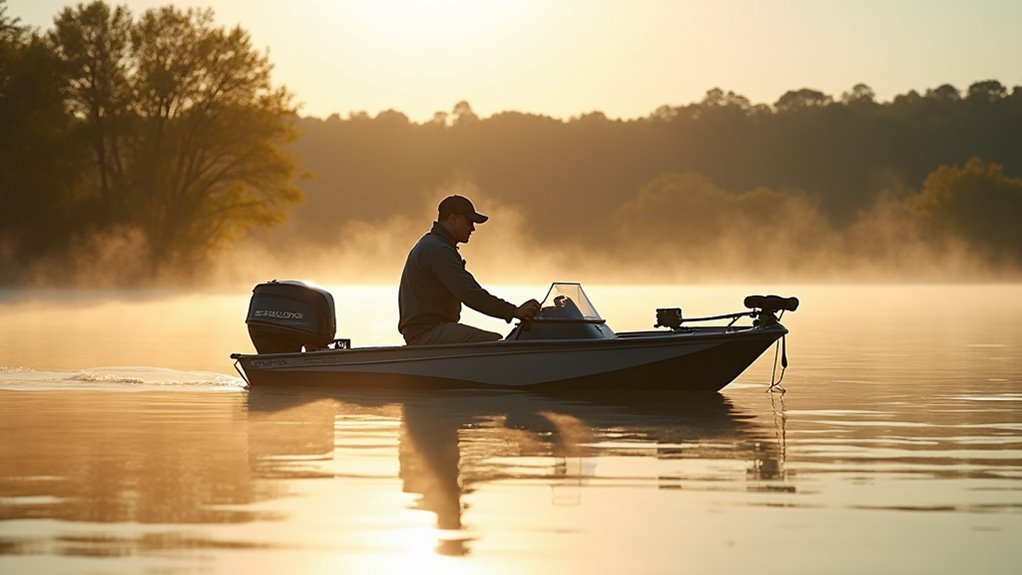
Positioning our trolling motor perfectly is essential for maximizing its versatility and ensuring smooth sailing. By adjusting the depth collar, we can adapt to various water conditions, enhancing motor efficiency. Let's make sure the propeller sits at least one foot below the surface for best performance. For those days when the water depth changes frequently, using two collars to set min and max depths keeps us prepared. Remember, checking the collar's tightness is key to avoid slips that could disrupt our adventure.
Creating the right balance for shallow waters involves raising the propeller to prevent any bottom dragging. A deeper propeller ensures better traction and forward thrust, which is crucial in achieving optimal performance. If we're in shallow areas often, a shorter shaft might be beneficial. Having the propeller break the water surface can substantially affect motor efficiency, so let's adjust gradually until we hit the sweet spot for our specific water conditions.
| Water Condition | Ideal Depth Adjustment | Motor Efficiency Impact |
|---|---|---|
| Calm waters | 1 foot below surface | High |
| Shallow waters | Raise propeller, avoid surface | Moderate |
| Varying depths | Use 2 collars for range | Consistent
Choosing the Right Collar for Your Motor
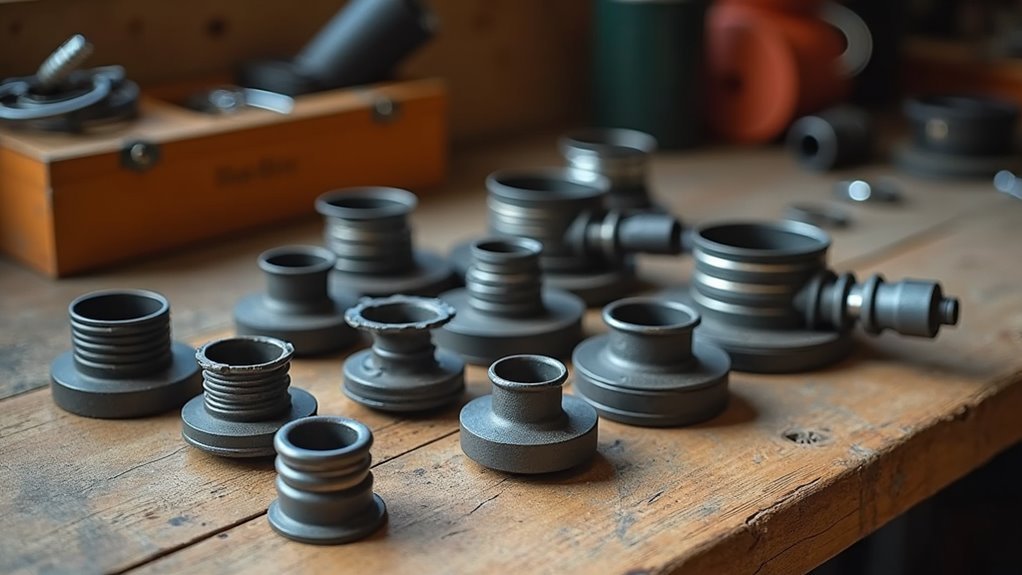
Selecting the right collar for our trolling motor plays a significant role in maintaining its effectiveness across different water conditions. When we're out on the water, having a collar that fits our motor perfectly guarantees we can adjust quickly and handle whatever the day throws at us.
We should start by considering collar materials, which impact durability and performance. A sturdy, high-quality material means fewer headaches and more freedom to explore. It's worth noting that Lakeside Marine and Service offers a variety of depth collars and shafts in stock for immediate shipment, providing us with a wide range of choices and convenience.
Compatibility issues crop up when we overlook details like shaft length and diameter. Whether it's a 54" or 72" length, or a shaft diameter of 1.25", selecting a collar that matches our motor precisely is vital. Voltage compatibility, like 12v or 36v, also matters to guarantee we don't face any unexpected hiccups.
Additionally, knowing our motor model helps avoid gaps in performance, whether it's a Minn Kota Ultrex or another.
Third-party solutions and specialized collars offer freedom of choice, so if what we need isn't on the shelf, retailers can special order collars. Remember, using resources like parts diagrams and serial number lookups can make this process smooth.
With the right collar, we're set for more adventure.
Maintaining Your Adjustable Depth Collar
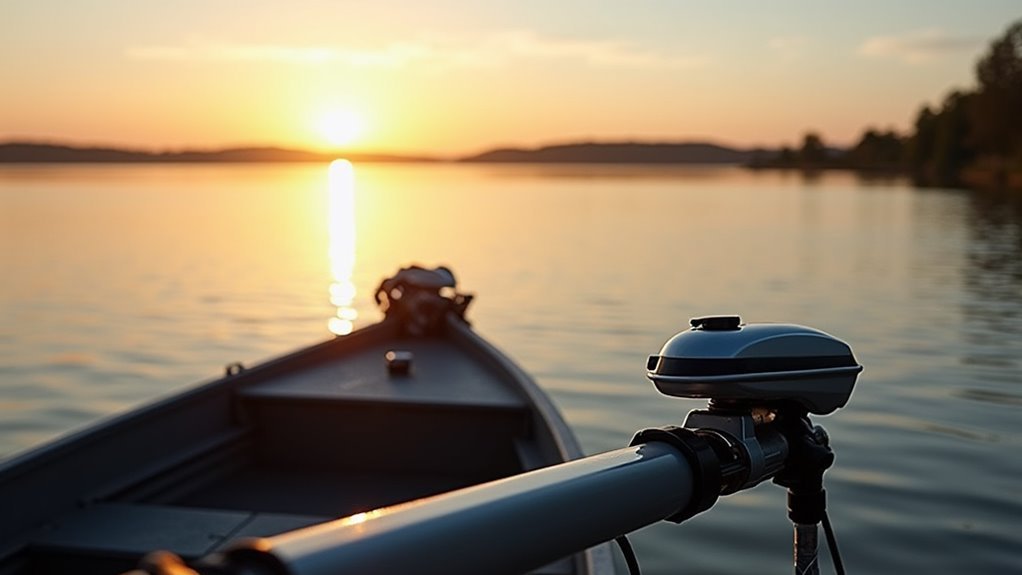
How do we guarantee our trolling motor's adjustable depth collar remains in top working condition? First, we focus on depth calibration by making certain the motor sits halfway between stowed and deployed positions before making any adjustments. A careful loosening of the collar is essential to prevent unexpected sliding, granting us peaceful control over our adventures on the water.
To keep our freedom intact, we must inspect the collar regularly for wear and damage, which could impair its functionality. A snug, but not overly tight, fit is key for maintaining proper depth calibration. This keeps the motor well-positioned, allowing us to easily explore different water depths without a hitch.
Collar lubrication is a vital part of our preventive maintenance routine. By making sure the parts move smoothly, we can avoid unexpected malfunctions that might tether our sense of adventure. Ensuring the coiled cable is free of tangles or damage is part of verifying that all components are in good working condition.
Keeping a keen eye on the coiled cable ensures it moves freely without conflicting with the steering, preserving our flexibility. In the spirit of readiness, having spare parts, like depth collars and ropes, at hand means we can tackle any sudden challenges. Maintaining our trolling motor's depth collar extends the journey, making certain uninterrupted adventures every time we set sail.
Common Problems and Solutions
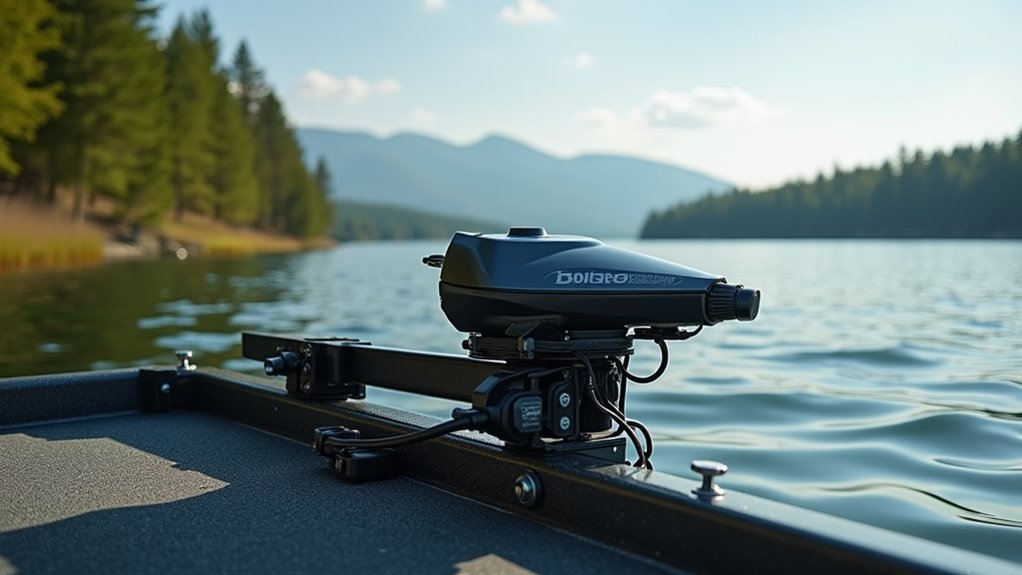
As we set out on our trolling adventures, understanding common problems with our adjustable depth collars guarantees a smoother experience. We often hear about collar slipping, which happens when they're not tightened enough. Tightening methods like using channel locks or securing them by hand can help immensely. Utilizing full bottles of water is an innovative method to adjust the motor depth quickly, especially in shallow waters, complementing traditional methods such as collars.
Feedback from users shows adding extra collars can stabilize our depth setup, and regular readjustments confirm we're ready for any water depth.
When it comes to collar material, durability is key. Weak points might lead to cracking under stress, but replacement collars are easy to find and install. For example, checking manuals or online resources for part numbers like the Ultrex's 2C-131-A guides us to the right pieces.
Users sometimes mention installing collars can be tricky, involving disassembling head covers and reconnecting power wires. Knowing this in advance prepares us for a hands-on fix.
Adjustments with two collars on the shaft lets tweak minimum and maximum depths easily. It's handy especially when shallow water challenges us. Our freedom on the water starts with understanding these solutions and user feedback helps too, confirming a worry-free fishing trip.
Enhancing Fishing Success With Adjustments
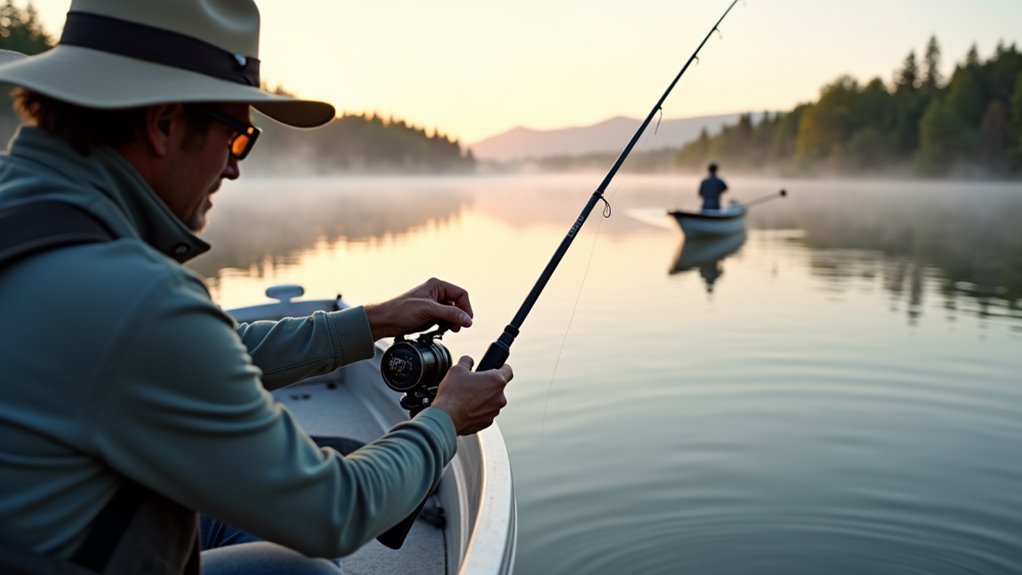
Enhancements in trolling motor technology not only make our fishing trips more enjoyable but also substantially improve our success rates. With the ability to fine-tune our fishing techniques, we're offered unmatched control over our drift strategies. Imagine effortlessly adjusting drift speeds to match conditions, ensuring your bait presentation is just right for that elusive catch we've been after. Trolling motors utilize remote control features to provide easy maneuvering from anywhere onboard, adding even more flexibility to our fishing experience.
With these innovations, we're not just talking about drifting aimlessly. We use features like Autopilot and True North to maintain a specific heading, even when the wind tries to blow us off course. This precision allows us to tailor our fishing techniques perfectly:
- Control Over Drift Speed: We can easily adjust how fast we drift, which helps us present our lures most effectively.
- Precision in Drift Patterns: Real-time adjustments let's match our drift patterns to changing conditions.
- Enhancing Bait and Lure Presentation: With adjusted speeds, our baits stay where they need to be, even above tight structures.
Using a trolling motor, we can cover more water silently, increasing our chances of success without the constant need to reposition. This freedom allows us to focus on the joy of fishing, turning every trip into a rewarding adventure.
Frequently Asked Questions
How Can Adjustable Depth Collars Impact Battery Life and Motor Efficiency?
We've found that optimizing depth settings can substantially reduce power consumption, leading to energy savings and extending battery life. This freedom lets us explore longer without worry, ensuring efficient and adaptable motor performance across various conditions.
Are Adjustable Depth Collars Compatible With All Types of Trolling Motors?
It's funny how coincidences reveal truths—adjustable depth collars aren't universally compatible with all trolling motor types. Motor compatibility hinges on bracket design and brand specifications, ensuring we freely explore waters without constraints on our adventures.
Can Depth Collars Be Used in Saltwater Environments Without Corrosion Issues?
We can use depth collars in saltwater if we guarantee saltwater resistance and implement corrosion protection measures. By selecting materials wisely and maintaining them properly, we prevent corrosion, giving us the freedom to explore without limits.
How Do Adjustable Depth Collars Influence Noise Levels of Trolling Motors?
Did you know 60% of anglers report quieter motors with optimized setups? We can adjust depth collars to achieve cavitation reduction and proper propeller alignment, minimizing noise. Let's explore these techniques for an unobtrusive and liberated fishing experience.
What Materials Are Adjustable Depth Collars Typically Made From?
We use materials like plastic, stainless steel, composites, and aluminum for adjustable depth collars. These guarantee material durability and are carefully chosen during the manufacturing process to withstand conditions, offering freedom to explore without worry.
Conclusion
In closing, let's remember that about 70% of anglers who adjust their trolling motor depth report better fishing results. Isn't that amazing? By using adjustable depth collars, we can smoothly navigate different water conditions and stay on top of our game. Whether tackling shallow or deep waters, these collars help us stay in control and adapt to whatever Mother Nature throws our way. Let's embrace these tools to enhance our fishing adventures and reel in success!